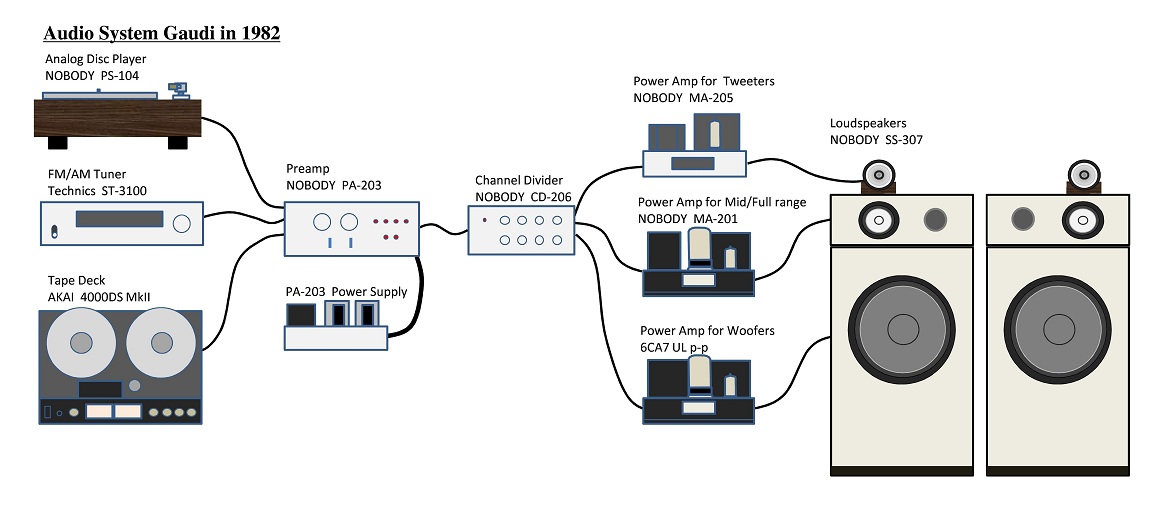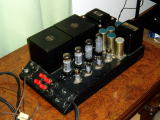Gaudi in 1982
2011/04/03 created
2021/05/06 updated
The contents of this page were reprinted from the previous homepage of mine, 'Tonochi's Audio Room'. Some parts were edited.
In January, 1982, when I had spare time after finishing my graduation thesis,
I started handiwork of as many as four sets of equipment in order to realize
the multi-amplifier system I had wanted for so long. They were analog disc
player PS-104, power amplifier for tweeters MA-205, channel divider (network)
CD-206, and loudspeaker SS-307. In July, during a training period after
employment, the three-way multi-amplifier system was realized at last.
I used Fostex FE106 Sigma, a sister product of the full-range driver FE103,
which I was using for years, instead of a horn-loaded midrange, since I
couldn't afford. This became a chance hit and I came up with one idea:
switching FE106 to full-range/midrange, that is, the system was switchable
to the three-way multi-amplifier system and the full-range single-amplifier
system. I planned to switch the system configuration according to what
I wanted: the multi-amplifier configuration when I wanted to listen thoroughly,
and the single-amplifier when I wanted background music.

I had a limited budget, as I made the four sets for that short period;
I spent much for some, and less for the others. It was the tweeter that
I spent most. Though I felt like saying that Fostex T925 was too extravagant
with me, I bought it decisively on the assumption that I would use it for
many years to come. It cost me about 35,000 yen for two units, if I remember
correctly. This decision was wise. The sound quality of T925 was wonderful
and it upgraded the system as a whole. T925 taught me that a good tweeter
had influence even on low-pitched sound.
For the other parts, I suppressed the budget by finding a used article
or a real bargain. The woofers, Pioneer PW-A31, were used ones that were
on sale in the column called "Part Exchange" of MJ magazine.
As for the midrange, I used full-range drivers as mentioned above.
The parts of the analog disc player were bargains I found at Akihabara. I remember many of parts related to analog players were discounted sharply, since it was just the time the first CD went on sale. I bought the tone arm, Grace G-1040, for 14,000 yen despite its list price of 28,000 yen, and the turntable, Sony TTS-8000, for 20,000 yen despite its list price of 80,000 yen. Both were brand-new.

I held down the cost of the amplifiers thoroughly. The power amplifier for the woofers may have been expensive, if new parts were used. So I decided to use used parts. At that time, I found a 6CA7 PP power amp made by an audiophile in the "Part Exchange" column of MJ magazine. It was on sale as a junk. I contacted him, and bought it at a low price. It worked after I fixed it up. I decided to use it as it was.
I used MA-201 for the midrange. I misunderstood one thing. The output power of MA-201 was 20W+20W at that time, and that of the 6CA7 PP was 40W+40W. And the sensitivity of the midrange driver, FE106 Sigma, was 90dB/W, and that of the woofer, PW-A31, was 93dB/W. That is, the midrange needed a more powerful amp. You may think the woofer needs a more powerful amp than midrange, judging by its looks. But the idea is wrong. The lower the sensitivity of the driver, the more power it needs actually.
The power amp for the tweeters was MA-205, of which circuit was one I designed
on my own for the first time in my life. To hold down the cost, I used
multiunit tubes (6GW8) and cheap output transformers. As a result, the
output power was only 4W.
All the parts for CD-206 were cheap. Its cost was less than 10,000 yen.
I was so excited when I listened to the three-way multi-amp system for the first time. Especially, I was delighted by its extended lows. I was starved for extended lows, as I had been using full-range drivers for a long time. Since then, I sometimes listen to rock music, which I had not been interested before. My favorite song was The Knack's My Sharona (The Knack, Get The Knack, Capitol ECS-81250). I recall I listened to it almost every day.